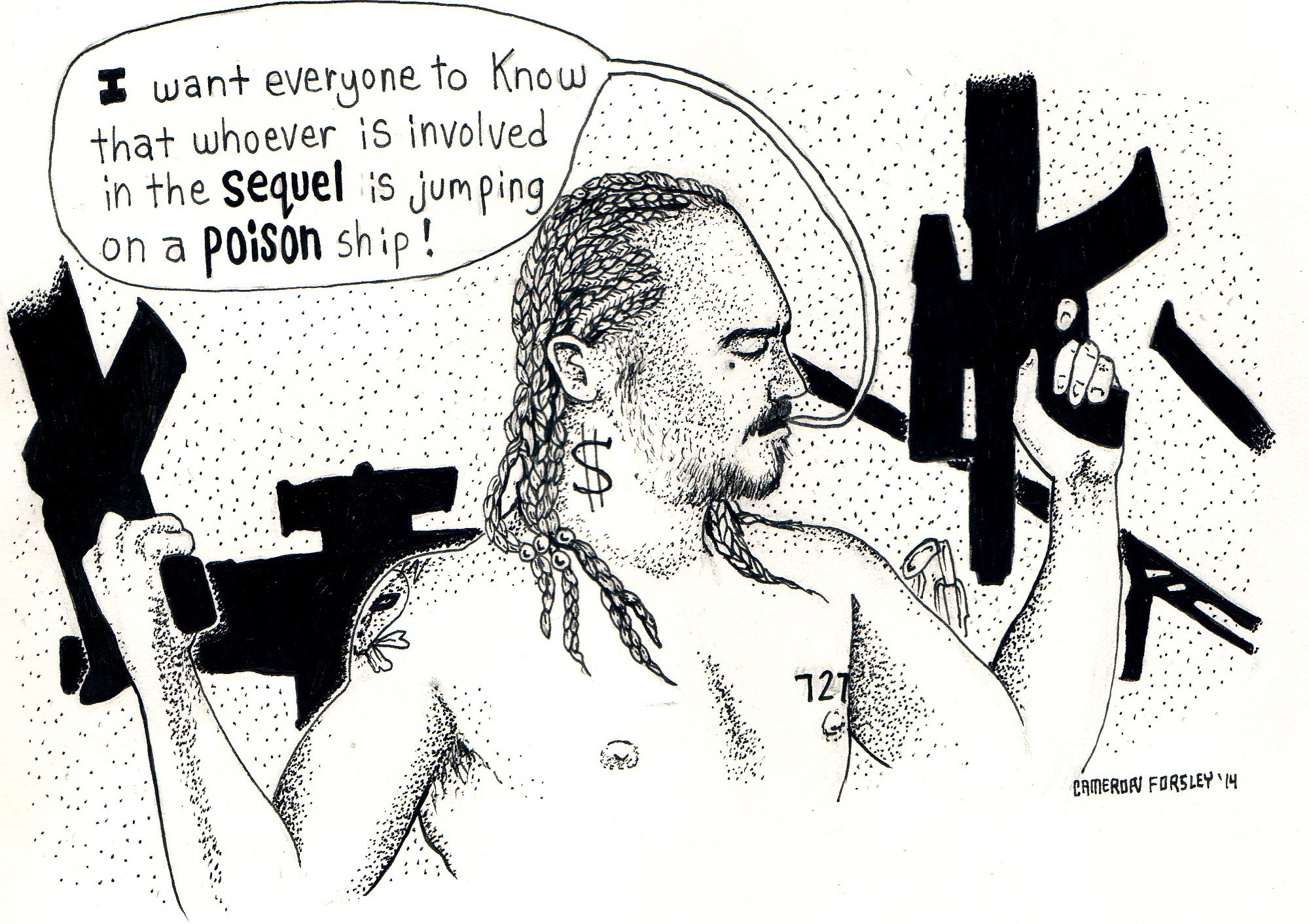Last week, on my Facebook News Feed, this message from Harmony Korine, director of Spring Breakers (2013), popped up:
Like what the F$$$ so some guy decided to make spring breakers two without mine our James permission lame muthafuker!
Turns out that the lame mother-fucker who decided to make a Spring Breakers sequel without Korine’s blessing is a Paris-based production company called Wild Bunch. Working with Muse Productions, the company behind Korine’s film, they’re releasing Spring Breakers: The Second Coming (2015), which will showcase the girls battling a group of Christian extremists who are trying to convert them. Although the reports of Irvine Welsh—the subversive but apparently money-hungry Scottish author of Trainspotting—writing the script sound promising, the news that Jonas Akerlund (Spun, Small Apartments) is directing worries me.
I’m not worried that it will be the “terrible film” made “to make money off someone else’s creativity” that James Franco, whose Alien character drives the plot and defines the themes of Spring Breakers, predicts on his Instagram. . .because I know it will be exactly that. I’m worried that many of the fans of Spring Breakers—who also act as the film’s subject and supporting-cast—will be under the impression that Korine is involved with this money-making scheme. In fact, the producers of this cheap knock-off of a sequel probably chose Akerlund to direct it for this very reason—as one of the most productive and sought-after music video directors of the last two decades, he has perfected a soulless MTV directing style that can, if you’re not paying attention, bring to mind some of the scenes in Spring Breakers. Take, for example, the opener, where Korine captures in slow motion the spring break beach party that MTV has been shitting out of televisions for decades: tities are dancing, biceps are bursting, girls are sucking on their popsicles like porn stars sucking cock, and guys are squeezing their ball-sacks like outfielders getting the last out in a no-hitter. While such a scene masterfully mocks Akerlund’s tactless techniques, I’m worried that some viewers may not see a difference between the two.
But I have to admit: I was also worried when I first heard about Spring Breakers. In March 2012 I wrote about my worries of Korine working for the first time within the Hollywood system, in an essay titled, “Flavor Flav is a Classically Trained Pianist, Tom Petty has a Dirty Fish Tank, and Selena Gomez is Starring in Harmony Korine’s New Flick.” However, in spite of my worries, I concluded that essay by expressing my faith that Korine—an avant-garde Frankenstein of a filmmaker known for creating beautifully grotesque monsters such as Gummo (1997), Julian Donkey-Boy (1999), and Trash Humpers (2009)—would melt his Spring Breakers cast of wholesome Disney toys down and then re-form (or maybe reform?) them into decadent sex toys so that America’s youth could witness the dark perversions of this country’s psyche. But that’s not what happened. The dark perversions that America’s youth witnessed in Spring Breakers didn’t belong to this country’s psyche. . .they belonged to their own.
I interpreted the first film as both a satire and a celebration of today’s youth, but, above all, as a mirror reflecting their delusional dreams and disillusioned desires. “Three hundred years from now, when people want to look back at this time. . . they will go to Spring Breakers,” the legendary German director Werner Herzog told Franco. And I agree. It’s not a perfect film, but neither are the realities it reveals. Just as Jean-Luc Godard’s groundbreaking triumph of New Wave cinema, Breathless (1960), used innovative cut-shots, minimal dialogue, and lively on-set locations to depict the liberated youth of the late 1950s, Korine’s Spring Breakers uses neon color palettes, a scandalized cast of Disney starlets, and over-produced pop music to depict the corrupted youth of the early-2010s.
Film critic Pauline Kael wrote this about the characters in Breathless:
They are as detached as a foreign colony, as uncommitted as visitors from another planet, yet the youth of several countries seem, to one degree or another, to share the same characteristics. They’re not consciously against society: they have no ideologies at all, they’re not even rebels without a cause. They’re not rebelling against anything—they don’t pay that much attention to what doesn’t please or amuse them. There is nothing they really want to do, and there’s nothing they won’t do. . . The codes of civilized living presuppose that people have an inner life and outer aims, but this new race lives for the moment, because that is all that they care about.
This new race that Godard exposed to the world with Breathless is not much different than the one Korine exposes with Spring Breakers. But there is one difference: today’s youth, unlike the youth of the late 50s, is constantly morphing—both culturally and demographically. Whether it is degree-holding adults living with their parents and using the latest slang like perpetual teenagers or unemployed teenagers financing trips to Europe with credit cards and refusing to wash their own underwear like well-off Wall Streeters, today’s youth is made up of individuals who are both more complicated and more corrupted than those that came before them. The rise of smartphones has created an environment where marketing propaganda and social pressures never cease, and, as a result, the identities of today’s youth are shaped entirely by outside sources that have sinister ulterior motives inherent to them. Their desires and dreams are dictated by the whims of capitalism gone wrong, and Franco, via his Alien character, exemplifies this phenomenon when he shows his little “mermaids” around his crib and delivers the following “Look at my Sheeyit!” monologue:
This is the fuckin’ American dream. This is my fuckin’ dream, y’all! All this sheeyit! Look at my sheeyit! I got. . .I got shorts—every fuckin’ color! I got designer T-shirts! I got gold bullets. . . I got Scarface—on repeat. Scarface on repeat! Constant, y’all! I got Escape. Calvin Klein’s Escape! Smell nice? I smell nice! That ain’t a fuckin’ bed—that’s a fuckin’ art piece. My fuckin’ spaceship! U.S.S. Enterprise on this shit. I go to different planets on this motherfucker! Me and my fuckin’ Franklins here—we take off. Take off! Look at my shit. Look at my shit! I got my blue Kool-Aid. I got my fuckin’ Nun-chucks. I got shurikens—I got different flavors. I got them sais. Look at that shit—I got sais. I got blades! Look at my sheeyit! This ain’t nuttin’, I got rooms of this shit! I got my dark tannin’ oil. . .lay out by the pool. . . put on my dark tanning oil. I got machine guns: look at this—look at this motherfucker here! Look at this motherfucker! Huh? A fucking army up in this shit!
Today’s youth buy what they are told to buy and live as they see others live. Their accessories shape their identities. Their televisions mold their realities. They believe that it’s cute to wear Hello Kitty, but it’s sexy to text nudes of themselves to classmates. . .so they do both. And for them, coastal Florida during spring break is, as Faith (Selena Gomez) tells her God-fearing Grandma,”the most spiritual place [they’ve] ever been.”
While films such as Basketball Diaries (1995), The Rules of Attraction (2002), Thirteen (2003), and Bling Ring (2013) have touched upon this troubling mentality of modern youth, and other films like Kids (1995)—which Korine wrote as a 19-year-old, Bully (2001), and Elephant (2003) have managed to conjure this mentality, only Spring Breakers successfully expounds upon every element of it in a way that compares to what Godard did with Breathless. Only Korine, because he loves today’s youth, understands today’s youth and how the movies have replaced bibles as their moral compasses. “Act like you’re in a movie or something,” his cast of Disney starlets tell themselves, over and over, before violently robbing a diner to finance their spring break.
Because Spring Breakers is a magnetically stylized movie, Korine is able to take his audience into the depths of the crazy contradicting consciousness’ of these technology fueled, commercially brainwashed, immoral monsters that populate America’s malls, fill university campuses, and all share the same goal: to be on spring break forever.
But at the film’s conclusion, it is clear that spring break has to end. Just as Korine had to sober up to start this film, Alien had to die to end it. The producers of Spring Breakers: The Second Coming fail to understand this: it doesn’t matter if they, as one of them stated, “have all rights to all prequels, sequels, remakes,” because spring break is over. Franco wrote that “whoever is involved in the sequel is jumping on board a poison ship,” and he’s right. Akerlund, the director of this poison ship, has spent the last three decades putting out music videos for the likes of Beyonce, Lady Gaga, Madonna, and Jennifer Lopez. And after experiencing the powerful visuals projected by Korine and his cinematographer, Benoît Debie, Akerlund’s MTV music videos come off as the aesthetically challenged, plastic presentations they are. Spring Breakers: The Second Coming will be no different, and paying to see it because it steals the name of the original would be just as foolish as paying for some steel-tipped cotton swabs because they steal the name Q-Tips.
***
Rumpus original art by Cameron Forsley.





